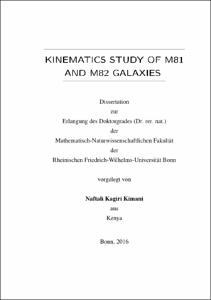Kinematics study of M81 and M82 Galaxies

Kinematics study of M81 and M82 Galaxies

| dc.contributor.advisor | Menten, Karl M. | |
| dc.contributor.author | Kimani, Naftali Kagiri | |
| dc.date.accessioned | 2020-04-23T01:04:13Z | |
| dc.date.available | 2020-04-23T01:04:13Z | |
| dc.date.issued | 21.12.2016 | |
| dc.identifier.uri | https://hdl.handle.net/20.500.11811/6934 | |
| dc.description.abstract | The measurement of proper motion combined with the radial velocities, is an important tool for our understanding of the dynamics and evolution of galaxies in a group environment. One of the nearest group is the M$,$81 group at a distance of $sim$3.63$pm$0.34$,$Mpc citep{Freedmann1994}. It is a fascinating interacting galaxy system consisting of the galaxies M$,$81, M$,$82 and NGC$,$3077. In the first part of this work, we present the proper motions of M$,$81 and M$,$82 galaxies, derived from Very Long Baseline Interferometry (VLBI) radio observations. The observations were conducted in three epochs between 2007 and 2009 at X- (8.4$,$GHz) and U-band (15.3$,$GHz), and four epochs between 2007 and 2015 at K-band (22.2$,$GHz). On the one hand, the proper motion of M$,$81 relative to Milky Way was derived from background quasars (0945+6924, 0948+6848, 1004+6936). This was done by fitting a rectilinear motion to the position offsets of the quasars. The positions offsets of quasar 0948+6848 were found to be contaminated from its jet motion. We averaged the observed proper motion of the other two quasars to obtain the proper motion relative to the Sun of M$,$81 as $mu_{alpha}=0pm5.7,$$mu$as$,$yr$^{-1}$ and $mu_{delta}=mathrm{-22.5pm2.1},$$mu$as$,$yr$^{-1}$ at 22.2$,$GHz. Correcting for the peculiar motion of the Sun and the rotation of the Milky Way, this measurement yields a proper motion relative to the Milky Way of 10.2$pm$5.7$,$$mu$as$,$yr$^{-1}$ ($sim$179$pm$100$,$km$,$s$^{-1}$) towards the East and $-$24.5$pm$2.2$,$$mu$as$,$yr$^{-1}$ ($sim$$-$429$pm$39$,$km$,$s$^{-1}$) towards the North. With the total radial motion of M$,$81 towards the Milky Way reported as 73$pm$6$,$km$,$s$^{-1}$, we derive the total space velocity of M$,$81 relative to the MW as 471textpm 108$,$km$,$s$^{-1}$. On the other hand, the proper motion of M$,$82 is derived from observations of three H$_{2}$O masers located at opposite sides of its dynamic center. After correcting for the internal rotation of M$,$82, the average observed proper motion of the three maser features yields a proper motion relative to M81 of $mu_{alpha}$= 8.3$pm$5.5$,$$mu$as$,$yr$^{-1}$ (143$pm$95$,$km$,$s$^{-1}$) towards the East and $mu_{delta}$= 10.6$pm$4.3$,$$mu$as$,$yr$^{-1}$(182$pm$74$,$km$,$s$^{-1}$) towards the North. With a derived radial motion of 237$pm$6$,$km$,$s$^{-1}$ towards M81, we obtain its total space velocity to be 331$pm$120$,$km$,$s$^{-1}$ relative to M$,$81 galaxy. Moreover, with a separation distance between the centers being 38$,$kpc, M$,$82 is embedded in the dark matter halo of M$,$81, and can be considered bound. We therefore derive a lower limit of the mass of M$,$81 to be (4.8$pm$0.6)$times$10$^{11}$M$_{odot}$. In the second epoch of the observations of the water masers in M$,$82, a bright new radio source was discovered citep{Brunthaler2009a}, which turned out to be a new supernova. This led to a follow up program with the Very Large Array (VLA) and VLBI, which represents the second part of this thesis. We fit two models to the data, a simple power-law, $Spropto t^{beta}$, and a simplified Weiler model, yielding decline indices, $beta$, of $-$1.22$pm$0.07 (days 100 --1500) and $-$1.41$pm$0.02 (days 76--2167), respectively. The late time radio light curve evolution shows flux-density flares at $sim$970 and $sim$1400 days which are a factor of $sim$2 and $sim$4 higher than the expected flux, respectively. We derive the spectral index, $alpha$, $mathrm{S_{nu}proptonu^{alpha}}$, for frequencies 1.4 to 43$,$GHz for SN$,$2008iz during the period from $sim$430 to 2167 days after the supernova explosion. The value of $alpha$ shows no signs of evolution and it remains steep ($approx$$-$1) throughout the period, unlike that of the well-studied SN$,$1993J which started flattening at $sim$day 970. From the 4.8 and 8.4$,$GHz VLBI images, the supernova expansion is seen to start with a shell like structure that gets more and more asymmetric, then breaks up in the later epochs with bright structures dominating the southern part of the ring. This structural evolution differs significantly from that of SN$,$1993J which had remained circularly symmetric over 4000 days after the explosion. The VLBI 4.8 and 8.4$,$GHz images are used to derive a deceleration index, $m$, for SN$,$2008iz, of 0.86$pm$0.02, and the average expansion velocity between days 73 and 1400 as (12.1$pm$0.2)$times$10$^{3}$$,$km$,$s$^{-1}$. From the energy equipartition between magnetic fields and particles, we estimate the minimum total energy in relativistic particles and the magnetic fields during the supernova expansion and also find the magnetic field amplification factor for SN$,$2008iz to be in the range of 55 to 400. | en |
| dc.language.iso | eng | |
| dc.rights | In Copyright | |
| dc.rights.uri | http://rightsstatements.org/vocab/InC/1.0/ | |
| dc.subject | M81 Group | |
| dc.subject | Proper Motion | |
| dc.subject | Phase-referencing | |
| dc.subject | Supernova | |
| dc.subject | SN2008iz | |
| dc.subject.ddc | 520 Astronomie, Kartografie | |
| dc.subject.ddc | 530 Physik | |
| dc.title | Kinematics study of M81 and M82 Galaxies | |
| dc.type | Dissertation oder Habilitation | |
| dc.publisher.name | Universitäts- und Landesbibliothek Bonn | |
| dc.publisher.location | Bonn | |
| dc.rights.accessRights | openAccess | |
| dc.identifier.urn | https://nbn-resolving.org/urn:nbn:de:hbz:5n-45603 | |
| ulbbn.pubtype | Erstveröffentlichung | |
| ulbbnediss.affiliation.name | Rheinische Friedrich-Wilhelms-Universität Bonn | |
| ulbbnediss.affiliation.location | Bonn | |
| ulbbnediss.thesis.level | Dissertation | |
| ulbbnediss.dissID | 4560 | |
| ulbbnediss.date.accepted | 22.11.2016 | |
| ulbbnediss.institute | Mathematisch-Naturwissenschaftliche Fakultät : Fachgruppe Physik/Astronomie / Argelander-Institut für Astronomie (AIfA) | |
| ulbbnediss.fakultaet | Mathematisch-Naturwissenschaftliche Fakultät | |
| dc.contributor.coReferee | Kroupa, Pavel |
Dateien zu dieser Ressource
Das Dokument erscheint in:
-
E-Dissertationen (4337)




